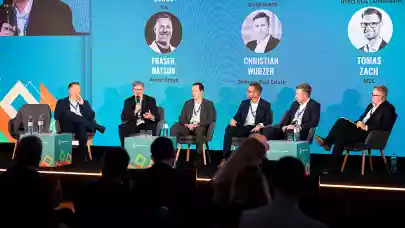
In the first half of the year, there was a sharp decline in the volume of real estate investments in Poland. Despite the market recovery at the end of summer, the total volume in Q1-Q3 2023 amounted to only €1.7 billion. After the first half of the year with few portfolio transactions, in the third quarter, there were already four - in the warehouse and retail sectors, but none of them exceeded the value of €100 million. Interestingly, despite the turmoil, the Polish investment market welcomed 3 new players this year. Avison Young Poland summarizes the property investment market in Poland in Q3 2023
Investment market - maybe small but still active
After a solid increase in the Polish GDP in 2022 (5.1% y-o-y), in 2023, amid muted global and euro area economic growth, Poland has been also experiencing a slowdown. However, according to the latest forecasts, a rebound in 2024 is expected as inflationary pressures gradually subside and financing conditions improve, with the highest increase projected in the CEE region.
Times remain challenging – elevated inflation and interest rates persist, rendering financing costlier and less accessible. Consequently, these factors are inevitably impeding transaction volumes, additionally disrupted by the pricing clash. Thus, despite liquidity comparable to 2016 and 2017 Q1-Q3 period results, the average volume per 1 deal is significantly lower (€32 million). These demanding market circumstances somehow deter institutions, but on the other hand, they attract professionals looking for strategic purchases.
The first half of the year saw a sharp dip in Polish real estate investment volumes, despite an upturn at the end of the summer. Thus, the total investment volume in Poland in the Q1-Q3 2023 period reached €1.7 billion, which is the lowest result recorded since 2015 in the analogous interval. After a plunge in H1 2023, Q3 saw 4 portfolio deals in industrial and retail, however, none of them exceeded €100 million. Interestingly, the Polish investment market in spite of turbulence has welcomed 3 newcomers so far this year, namely EIKA Asset Management, FREY and the Austrian family office purchasing convenience retail portfolio in Silesia.
Highlights:
- €1.7 billion – total investment volume in Q1-Q3 2023
- 57 transactions closed
- 50% - industrial sector’s share in the total volume of Q1-Q3 2023
Industrial market - to build or to buy?
The new pricing dynamics encouraged warehouse developers to consider acquisitions instead of constructing new assets to expand their portfolios in Poland. The costs of new investments are gradually approaching the attractiveness of acquisitions, which have become the real alternative nowadays. This strategic conversion may be seen in the example of GLP, who acquired a warehouse in Gdańsk from 7R and announced further acquisitions in the Polish industrial market.
During the Q1-Q3 2023 period, the industrial sector played a significant role in driving Polish investment activity, accounting for half of the total investment volume. Out of the 20 closed deals, only two of them surpassed the €100 million threshold. These notable transactions included the acquisition of an 80% stake in 7R by NREP and the sale of Campus 39 in Wrocław to P3 by Panattoni. In contrast to the first half of the year, where single assets dominated, two small portfolio transactions were closed in Q3.
Excluding the 7R M&A, the industrial hub in Wrocław contributed to 36% of the total transaction volume in this sector. Collectively, the Big Five markets managed to attract nearly €500 million in industrial investment volume.
“The year 2023, from the perspective of warehouse developers, is characterized by very deliberate land acquisitions", comments Bartłomiej Krzyżak, Senior Director, Investment at Avison Young. "With the continually rising costs of financing, changing construction costs, and pressure from investors for price reductions for ready-made warehouses, the land market is experiencing cumulative pressure. Currently, the most attractive plots are those that are best located and have building permits, allowing for rapid commencement of construction work.”
Industrial sector highlights:
- €842 million – total sector’s investment volume in Q1-Q3 2023
- 60% - share of the Big Five hubs in industrial investment volume in Q1-Q3 2023
- 2 portfolio transactions (out of 20 in total)
Retail market - retail parks are a stable investment option
The Polish retail investment market currently attracts investors with three major types of assets. The most numerous in terms of properties sold are retail parks and convenience schemes, which remain a safe bet. High interest in regional shopping centres and opportunistic assets dedicated to redevelopment confirms that investors continuously look for strategic purchases. Competitive prices and attractive locations of older shopping galleries make them a higher-yield alternative.
In the Q1-Q3 2023 period, the retail investment volume stood for €405 million. FREY, the newcomer from France, finalised the acquisition of the prime retail park in Gdańsk – Matarnia. Interestingly, in the analysed period, the market saw three retail park portfolio deals. AY provided advisory services in all of them – either investment or technical consultancy.
“In times of market uncertainty, investors tend to focus on the best projects, offering a perspective of long and stable income. The most important features of best quality retail parks and convenience schemes are great location, perfect visibility, excellent tenant mix with multiple anchors with long WAULT as well as other facilities operating nearby, additionally attracting customers”, explains Artur Czuba, Associate Director, Investment at Avison Young
We anticipate that in the next months, the retail real estate market in Poland will be dominated mostly by opportunistic and value-added assets. Nevertheless, with more and more new convenience schemes and retail parks being under construction, such properties should also be of interest to more core investors, looking for stable investment products with long WAULT.
Retail sector highlights:
- €405 million – total sector’s investment volume in Q1-Q3 2023
- 9/20 deals due to convenience retail in Q1-Q3 2023
- FREY – newcomer in the retail market in Poland
Office market - nothing but Warsaw
Unsurprisingly, investors interested in offices still focus on the Warsaw office market. All of 10 signed deals in Q1-Q3 2023 took place in the capital city. “On the radar are unchangeably core+ as well as value-add and opportunistic assets, dedicated for redevelopment or change of function. The office investment market will have to wait for the comeback of transactions regarding prime office buildings”, adds Marcin Purgal, Senior Director, Investment at Avison Young.
The biggest office deal so far this year in Poland was the sale of Wola Retro in Warsaw, where Avison Young represented Develia, in sales to Budapest-based Adventum Group for €70 million. The second largest transaction regarded Warta Tower, which was acquired by Cornerstone. This transaction confirms the increasing activity of the Polish capital, especially when value-add and opportunistic properties are concerned. Interestingly, Q3 was the first period this year, when assets located in the city centre were acquired.
As for the office sector, office buildings in regional cities may have a worse time in the coming months. Investors’ attention is currently focused on Warsaw, particularly in the lower-priced areas of Mokotów and Służewiec, where AY team is conducting several deals.
Office sector highlights:
- €267 million – total sector’s investment volume in Q1-Q3 2023
- 10 transactions closed
- All acquired assets are located in Warsaw
PRS - unfading interest
Demand for PRS is not weakening. Thus, the sector will continue to grow, and demand for rental units will remain at a high level, exceeding existing supply. In addition, due to the early stage of this sector, the Polish market is expected to attract both local and foreign investors, who can get higher rates of return on their investments than in Western European markets. However, more secure rental offers set in EUR must wait, as Polish tenants are not willing to pay in foreign currency in the unstable economic environment.
A significant impediment to the advancement of residential investments is the scarcity of available land in desirable locations within major Polish cities. Consequently, investors are actively exploring alternative strategies, such as acquiring parcels of land featuring older structures that can be repurposed or demolished. This has led to a burgeoning trend in the real estate market focused on property conversions. In Q1-Q3 2023 period, the volume of closed transactions in the PRS sector amounted to nearly €130 million. Among 6 assets developed in the forward funding investment scheme which were put on the market, 4 were located in Warsaw and the remaining 2 in Kraków. Heimstaden Bostad, which is the second most active PRS operator in Poland as far as projects under construction are concerned, completed the acquisition of the Marvipol portfolio and project in Czyżyny in Kraków. Forward funding deals were also finalised for NREP, AFI Europe and Aurec RE Europe (LivUp PRS platform).
Additionally, investors present during the CEE Property Forum in Vienna indicated the PRS sector as the second asset class, after warehouses, offering the best opportunities nowadays.
Looking forward
In conversations with investors at EXPO Real in Munich, our country continues to emerge as one of the most attractive investment markets. Therefore, despite the significantly reduced volume of transactions, investment activity remains high in terms of the number of deals. Thus, the structure of transactions is dominated by smaller projects, while there is a lack of large portfolios, as investors take a cautious approach to larger investments where prices have not yet corrected as expected.
Banks are taking a very selective approach to financing projects, currently undertaking mainly refinancing activities. Thus, when it comes to new purchases, cash investors have a very strong advantage and the opportunity to make very good deals. We can see the increased activity of the domestic capital.
In 2024, we will also see a high number of commercial bond redemptions generated by developers or investors and a large number of refinancings. So, it could be a time of intense discussions between owners and banks, and this could translate into the appearance of new assets on the market.
Yields have gone up and it looks like they are now stabilising. The sellers need to get used to the new pricing and the buyers need to sharpen their pencils a bit to get the deals done and convince the sellers to accept their offers. It is the pricing mismatch that has resulted in less activity in the market and a lower investment volume than in previous years.
We are now seeing the activity picking up after the summer. Hence the prospects for 2024 are cautiously optimistic. There is more happening, interest rates are set to stabilise and so will the entire market. Stability is the key driver for investment.



